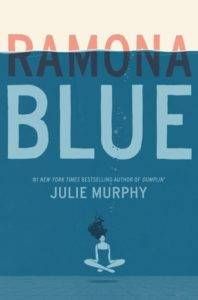
RAMONA BLUE and the Battle Between Bi, Fluid, and Lesbian Representation

Basically this is about a teenager who identifies as a lesbian, but ends up falling for a guy friend and reassessing her identity label. I mean, to be honest, it’s not really about that. It’s about Ramona, who is 6 feet tall, has blue hair, and lives in a trailer with her father, her pregnant sister, and her sister’s annoying boyfriend, and who feels like she’s bursting at the seams of her life. It’s about class and race and responsibility and possibilities. But that’s the part that’s drawn so much attention.
I’ll lay my cards on the table here. I’m bisexual. I identified as a lesbian for about 10 years before unexpectedly falling for a close guy friend. I am invested in this, especially since reading Sexual Fluidity by Lisa Diamond and realizing how common sexual fluidity is (especially in women) and how little it’s discussed or normalized.
So I took it a little personally when Ramona Blue got blasted with negative reviews from the premise alone. I was determined to get my hands on it and see for myself what the representation is like. Having now read it, spoiler alert: I don’t think it’s lesbophobic.
As I mentioned, Ramona’s identity label is not actually the focus of this story. This is a layered, nuanced narrative about balancing responsibility to others and to yourself. Ramona and Freddie’s relationship is not the main plot here. And even within their relationship, there’s a lot more going on than just Ramona dating a guy. They have to communicate across their differences: Freddie is a middle-class, straight black guy and Ramona is white, working class, and… not-straight. They don’t always find it easy to bridge these differences.
I thought that overall, the representation of Ramona’s sexuality was done well. (Julie Murphy is bisexual and is writing a bisexual character, so that isn’t surprising.) Perhaps I was more invested in the depiction of sexual fluidity than is fair: this doesn’t precisely reflect my experience, but why would it? Everyone’s experience is different. And I did have some issues with the depiction of their relationship–I wish Ramona had kissed Freddie first, for one, and I cringed when Ramona thought “rite of passage.”
Other aspects, though, were painfully accurate to my experience. Ramona feels guilty talking to her lesbian friend after kissing Freddie, feeling like she’s somehow betrayed her. This feeling of betrayal and guilt follows her in the beginning of her relationship. She feels like she’s losing her identity because she’s with him:
If I’m being honest with myself, there’s a small part of me that is sad every time I kiss Freddie, because I feel like little by little the person I thought I was is disappearing. Almost like I’ve lost what makes me special. But there has to be more.
Critics of Ramona Blue seem to talk about it as if being attracted to a guy for the first time is a free ticket out of queer town and into straight privilege, but that’s just not accurate. It’s a complicated, painful process of self-reflection, doubt, loss, and fear. Ramona thinks that lesbian “is just a word, but it still feels like it’s mine.” It’s hard to let go of part of your identity, even when it doesn’t describe your experience anymore. I think the part that hit me the hardest was Ramona struggling to tell her (distant, unsupportive) mother about her relationship, because she was afraid that her mom would be glad she was dating a boy. I remember bracing myself every time I told anyone in my life about my new relationship, because I didn’t want them to be too happy–or disappointed. Any reaction seemed to reflect badly on some part of my identity. (The correct response, by the way, was surprise and then congratulations for being happy.)
It’s not all discomfort, of course. In addition to the relationship she builds with Freddie, she also comes to terms in some way with her sexuality, even if she hasn’t nailed down a label yet. She recognizes that the love she has now doesn’t invalidate the love that she’s experienced before. She accepts that the future can be a “great and beautiful question mark.”
So is Ramona Blue lesbophobic? Only if you believe that calling yourself a lesbian and then experiencing attraction to a guy later in life and changing your identity label is lesbophobic. Ramona does not meet “the right guy” who “turns her straight”. She is not straight. She is absolutely sure of her attraction to girls throughout the entire book, it’s her attraction to one guy that’s in question.
Sexual attraction, romantic attraction, identity labels–this is complicated stuff. Some people know exactly who they are and what their emotional and sexual truth is early on. Some people discover it later, and try on different labels along the way. For some people, attraction can be fluid: they may find their patterns of attraction shift over time, or might discover an exception to the rule. Other people don’t experience fluidity in their attraction at all. (And this is very important: some sexuality is fluid. Not everyone’s! We can acknowledge sexual fluidity existing without saying it’s the same for everyone.)
We need stories in the world that recognize this complexity. Stories that represent the range of experiences with identity, attraction, and fluidity. We need stories about young lesbians who are completely solid in their identities and never like a dude in their lives and end up in adorable relationship with another woman and live happily ever after. But we also need stories about people who have complex, shifting desires and identities. There shouldn’t be a competition between bi, fluid, and lesbian representation. Because we need more of all three.
















